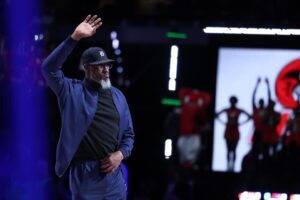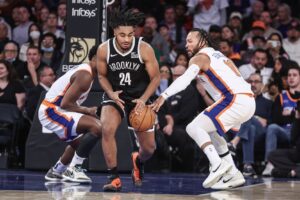The decision of the Golden State Warriors and the Cleveland Cavaliers to rest marquee players during nationally televised match-ups over the last two weeks prompted NBA commissioner Adam Silver to issue a memo to NBA team owners criticizing the practice. The basketball community has been buzzing since.
Commissioner Silver Issues Memo to NBA Owners
NBA commissioner Adam Silver sent a memo to NBA team owners Monday regarding the practice of resting star players for marquee games. ESPN’s Ramona Shelburne was the first to break the story.
According to Shelburne and other sources, Silver’s memo:
- States that the practice of resting star players is “an extremely significant issue” for the league.
- States that the issue of when to rest players will be discussed at the next Board of Governors meeting on April 6 in New York.
- Asks team owners to get involved in decisions about when to rest players because other members of organizations may not have the correct awareness of the impact those decisions have on “fans and business partners,” the reputation of the league and “perception of our game.”
- Warns owners that teams could face “significant penalties” for not obeying the league’s existing rules about reporting player unavailability.
Resting Players – Not a New Practice
Although currently a trending issue, the practice of resting players for marquee games is not new. As many pundits have noted, Gregg Popovich began resting aging stars Tim Duncan, Manu Ginobili and Tony Parker years ago to preserve them for playoffs. In fact, former NBA commissioner David Stern famously fined Popovich for resting his stars without giving the league proper notice during a nationally televised game against the Heat in 2012. Since that time, however, Popovich’s resting practices have been viewed equally with distain and admiration.
Renewed Interest in Issue after Warriors and Cavaliers Sit Stars
Renewed interest regarding the NBA’s rest policy came about March 11, when Golden State Warrior’s Coach Steve Kerr chose to rest stars Stephen Curry, Draymond Green, Klay Thompson and Andre Iguodala for a game against the San Antonio Spurs. The decision did not please fans, and certainly did not please ABC, who was airing the contest.
Kerr claimed that his decision to hold back Curry, Green, Thompson and Iguodala was based on health concerns, but the public was not buying it. Some speculated that Kerr was sending a message to the NBA; protesting a stretch of the Warriors schedule that he had previously described as “insane,” including eight games in eight cities in 13 days.
A week later, fans and ABC would again be disappointed. The Cleveland Cavaliers decided to rest LeBron James, Kryie Irving and Kevin Love during a 108-78 loss to the Los Angeles Clippers. Cleveland general manager David Griffin told ESPN’s Shelburne that the league called him shortly after the team announced its decision, to express its displeasure.
Griffin stood his ground, however, noting that it isn’t his job to appease the league and its television partners and telling ESPN that he gets paid “to win a championship.”
Griffin also attempted to differentiate the Cavaliers’ situation from that of the Warriors, asserting that the Cavaliers had legitimate reasons to rest at least two of their players (Irving: tightness in the left knee, and Love: recovering from left knee surgery) against the Clippers, while the Warriors choose to rest healthy players against the Spurs.
Future Hall of Famer James had his own take on the controversy, telling media outlets that the league only had a problem with players sitting because he’s been sitting.
LeBron James said the league only thinks sitting out is a "problem" because he's sat out a couple times this month.https://t.co/ZOHd2x3EkO
— clevelanddotcom (@clevelanddotcom) March 21, 2017
Van Gundy Weighs In
Always the voice of reason, ABC analyst Jeff VanGundy made his thoughts about resting players in marquee games known at numerous points during the Cavaliers-Clippers game.
VanGundy had also analyzed the Warriors-Spurs contest the week prior, and was obviously irritated by the relative lack of star-power on the court.
In criticizing the practice of resting players late in the season, VanGundy went so far as to call current players “soft”, opine that fans were getting “ripped off,” and state that the “bait-and-switch maneuver that the NBA allows its teams to pull” would be a “prosecutable offense” in any other business.
Former Players Speak Out
VanGundy was not the only one speaking out regarding the recent resting of players. Hall of Fame power forward Karl Malone did not mince words talking to ESPN.
(1/2) HOF'er Karl Malone: "if you don't have at least 10 yrs experience, get your a** playing. It's not work, it's called playing. Besides..
— Sage Steele (@sagesteele) March 19, 2017
(2/2) "…tell our underpaid service members & police & first responders to rest. Dammit, they can't"
— Sage Steele (@sagesteele) March 19, 2017
Another Hall of Famer, TNT analyst Charles Barkley, went so far as to suggest a fan boycott to stop the sitting phenomenon.
Talked #NBA players "resting" during the regular season with @NBAonTNT Charles Barkley and he did not hold back blasting all involved. pic.twitter.com/6aANtcdqih
— Rich Eisen Show (@RichEisenShow) March 20, 2017
Fifteen-time NBA All Star Kevin Garnett, while not opposed to the idea of resting players, expressed disapproval with the lack of “etiquette” shown by sitting players, specifically calling out James, for “sipping tea” courtside during his team’s loss to the Clippers.
.@LarryFitzgerald & @KGArea21 discuss whether resting players is good or bad for the game in the @MyStraightTalk topic. #PlayersOnly pic.twitter.com/ezSZeRLo95
— NBA on TNT (@NBAonTNT) March 21, 2017
Player Frailty in Today’s NBA
There is an undeniable correlation between fatigue and injury in the NBA that arguably justifies the resting of players down the stretch. Injuries are more likely to happen to tired players and are occurring more now than ever before. According to research from ESPN’s Kevin Pelton, incumbent All-Stars are missing about twice as many games due to injury as they did in the 1980s, and since 1978, teams that lost the NBA Finals suffered 2.5 more injuries to key players than the teams that won.
The challenges of the NBA schedule are not the sole reason for the prevalence of injury in the NBA, but they play a major role, along with today’s overkill basketball culture.
Due to the explosion of AAU and year-round youth ball, we are now seeing overuse and wear and tear type injuries in players at a much younger age. By the time a player reaches college, much less the NBA, they are likely to have participated in hundreds of games of competitive basketball, in addition to thousands of hours of practice and skills training.
Once in the NBA, the schedule is long and brutal. Teams play eighty-two games in seven months. They travel coast to coast, are subjected to numbers of back-to-back contests and are often obligated to play four games over the course of five nights. The frequent travel and time zone changes can have a negative impact on these athletes’ health and performance, and ultimately, on their teams’ championship aspirations.
The NBA’s Dilemma
The perennial dilemma for the NBA is, of course, figuring out how to reconcile the desire to have teams’ best product on the floor, particularly in the post-season, with a scheduling formula that puts franchise players and all-stars at an extremely high risk of injury.
Since Silver took over as Commissioner, there have been some positive strides. The number of back-to-backs (and in particular, long-distance back-to-backs and back-to-backs that cross time zones) has been reduced. The number of times teams have been required to play four games in five days has also been reduced, as has the number of miles traveled per team.
More changes are on the horizon.
The NBA and the National Basketball Players Association have reached a new collective bargaining agreement (CBA) which takes effect on July 1, 2017 for a seven-year term. Key points of the new CBA deal specifically with scheduling, and are intended to reduce injuries and reduce the need to sit players during regular season games. They include:
- Shortening the period for training camp and the pre-season by 7 days;
- Reducing the maximum number of exhibition games per team prior to any regular season from 8 to 6;
- Extending the regular season by one week, from 170 days to 177 days; and
- Increasing the number of days off that teams provide players during the Regular Season from 16 to 18.
The extra week in the schedule is anticipated to enable the NBA to cut down on back-to-backs, cut down on the number of times that our teams are obligated to play four games in five nights, and enable coaches to provide additional rest for their players without benching them for marquee games.
Final Thoughts
Teams with winning records whose playoff eligibility is confirmed will almost certainly keep their best players from playing back-to-backs after the All-Star break. Arguably, they’ve earned that right, and strategically it simply makes sense. Teams want to have the healthiest roster possible for the postseason; readiness for the playoffs is the priority.
The changes implemented by Commissioner Silver, described above, are a start, but don’t go far enough to address the circumstances that prompt teams to sit their marquee players. If players’ health really is paramount, and the league and networks are serious about avoiding the negative publicity of having teams like the Warriors and Cavaliers playing without their franchise players and stars, then the total number of games played in the NBA season needs to be revisited, as does the number games teams are permitted to play per week. Any changes in those areas are an unlikely pipe dream however, as they would most definitely impact the NBA’s most important asset: its bottom line.
Main Photo






